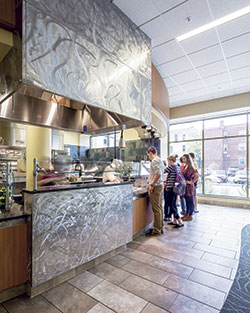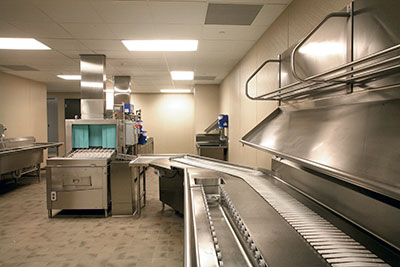Remodeling any existing foodservice facility comes with trials and tribulations, especially around determining which pieces stay and which get replaced. Making this determination represents a challenge for operators and any member of a project team but poses an even more unique task in college and university settings, with their high volumes and frequent menu changes, not to mention budgetary and other constraints.
 The design of the new stations at this University of Minnesota dining hall gives the foodservice operators the option of changing equipment as needed. Terry Pellegrino is a principal at Rippe Associates, a Minnesota-based foodservice consulting firm. Pellegrino has worked with the University of Minnesota on projects year-over-year, involving many equipment replacements. One of her more recent projects at the University of Minnesota was a new dining hall, the first built on campus since 2002, according to Pellegrino. "Replacement decisions revolve around a combination of volume needs, repair history and menu changes to meet current trends," Pellegrino says.
The design of the new stations at this University of Minnesota dining hall gives the foodservice operators the option of changing equipment as needed. Terry Pellegrino is a principal at Rippe Associates, a Minnesota-based foodservice consulting firm. Pellegrino has worked with the University of Minnesota on projects year-over-year, involving many equipment replacements. One of her more recent projects at the University of Minnesota was a new dining hall, the first built on campus since 2002, according to Pellegrino. "Replacement decisions revolve around a combination of volume needs, repair history and menu changes to meet current trends," Pellegrino says.
Just how do you know when to replace certain equipment, and when you've determined that, how do you replace the equipment? Pellegrino breaks it down.
When to Replace
Equipment that's clearly starting to fail in terms of its ability to get to and maintain proper temperatures or other performance-related issues can signal the need to replace a specific item.
Certain types of equipment have shorter lifespans than others. Steamers, ice machines and other equipment using water tend to have a life expectancy of about five to seven years, according to Pellegrino. High-temperature equipment can also burn out faster — this includes fryers, charbroilers and flattop grills, particularly the electric versions.
In college/university projects, she explains, "if you're renovating a whole project, it's sometimes better to replace these pieces at the same time so you don't have to go back in two years and try to replace them then, when the budget might be tighter and you might not get the funds to do so."
Measuring the performance of foodservice equipment can be a challenge at expansive colleges and universities. Some commissioning firms and service agencies will conduct audits, adding flow gauges to dishwashers, for example, to monitor the number of gallons per hour used and check other equipment for performance standards. "If the equipment is designed to use X amount of electrical power and it's using more, that can indicate a performance issue," Pellegrino says.
Nowadays, newer hood systems come with their own monitoring systems so managers can make sure they are working properly and efficiently, according to Pellegrino. And, if a project is LEED certified or following other sustainability criteria, those auditing bodies will often come in and examine the equipment to make sure they are not overusing on water or electricity, indicating a loss in efficiency and performance.
Repair History
Another clue to determining when to replace a piece of equipment is looking at the repair history for that particular appliance.
"If you're repairing something more than twice a year, we encourage our client to replace the equipment because it's a sign of problems, but also because the service costs will end up outweighing the cost of the new equipment over time," Pellegrino says.
Code Changes
Code changes can drive equipment replacement, particularly when it comes to hood systems. While many hoods can last decades, older models using mesh filters do not meet current codes, Pellegrino says.
Also, when operators change equipment that resides beneath hoods, they should also revisit the hoods themselves. "If you put fryers under a hood designed for steam-jacketed kettles, we know that doesn't meet code based on how much air it's pulling," Pellegrino says. "Older codes required a lot more exhaust for each piece than today. Custom-fabricated, preapproved hoods can run at lower air speed, so the payback on replacements can be pretty short."
Newer refrigerant requirements have also become a recent driver for replacements.
Operator Insights
 When specifying warewashers for a project at the University of Minnesota, the team from Rippe Associates compared three different types based on number of amps, number of kilowatts per hour, and racks per hour using baseline numbers they were able to extract from campus-wide utility information.In the case of the University of Minnesota, Pellegrino's team received regular feedback and insights from the operator about different types of equipment that were working less efficiently than others, which has impacted replacement decisions.
When specifying warewashers for a project at the University of Minnesota, the team from Rippe Associates compared three different types based on number of amps, number of kilowatts per hour, and racks per hour using baseline numbers they were able to extract from campus-wide utility information.In the case of the University of Minnesota, Pellegrino's team received regular feedback and insights from the operator about different types of equipment that were working less efficiently than others, which has impacted replacement decisions.
"I think colleges have gotten to the point where they have to do a better job of tracking of their equipment condition because historically they've band-aided equipment, and then it gets to the point where they have so much equipment in such disrepair that it becomes a huge investment to replace everything all at once," Pellegrino says.
Menu changes also drive equipment replacements. Colleges and universities "should be changing their menu every year," Pellegrino says, noting how students are far more educated than in years past when it comes to food. "This impacts equipment to a certain extent, so we try to build in flexibility as much as we can."
How to Replace
In the case of the University of Minnesota, Pellegrino ran various cost-benefit studies to determine the best equipment for the operator based on projected volume, frequency of use and performance standards.
For example, when examining heat-recovery systems, which use heat from the building and other appliances to preheat water used in other equipment, Pellegrino scoured manufacturer information, performance data from utility companies and the operator's current utility usage rates to make decisions about performance issues and potential
cost savings.
For dishwashers, Pellegrino's team compared three different types based on number of amps, number of kilowatts per hour and racks per hour with baseline numbers that they were able to extract from campus-wide utility information. Many of these newer models have much faster returns on investment.
Forecast for Flexibility
With so many menu changes at many colleges and universities, Pellegrino avoids building permanent equipment pieces under hoods. "We try to make the equipment as flexible as we can with disconnects, casters and an overall plug-and-play setup so the operator can pull one piece out and easily replace it with another," she says.
At the University of Minnesota, Pellegrino's team designed all the stations in 4-foot modules with the option of switching in and out different equipment like woks, countertop induction units, hot food wells, charbroilers, fryers and other equipment.
"Every station has electric, gas and enough exhaust capabilities so they can change out the equipment every day without spending extra on design changes," Pellegrino says. Demand-controlled ventilation with variable exhaust levels helps reduce exhaust when less is necessary.
Build in Budget
In the case of the University of Minnesota, a contract with Aramark includes a certain percentage of dollars returned to the school for maintenance and facility improvements.
Not every college or university is fortunate enough to have regular equipment replacement funds, so it's important for operators to forecast what they might need on a regular basis in order to make those improvements when the money becomes available.
Pellegrino helps colleges maintain documentation on the lifespan of different equipment to know when the time to replace that hood or walk-in cooler nears. While there is no cut-and-dried method to determine the lifecycle for a piece of equipment, Pellegrino often looks to the PG&E Food Service Technology Center's website for some guidance as well as manufacturer information.
Moving forward, maintaining the equipment once replaced is the most important task high-volume operators like colleges and universities have when it comes to preventing faster future replacements and maximizing energy savings.




